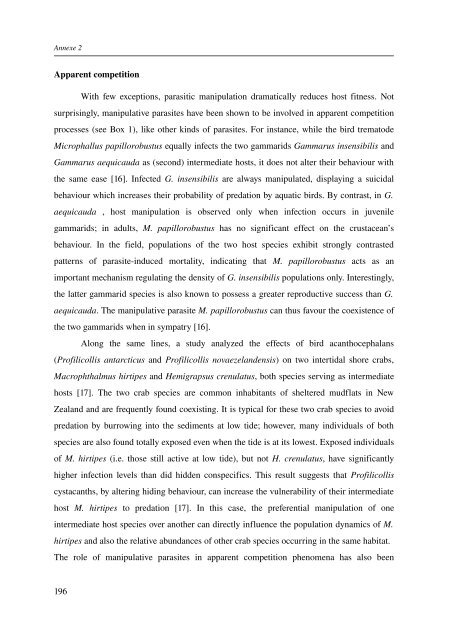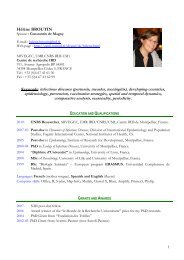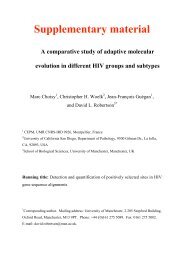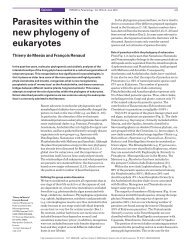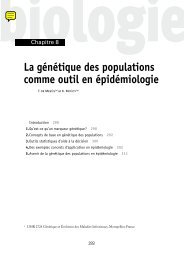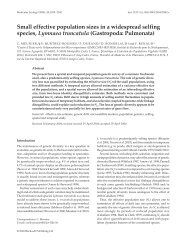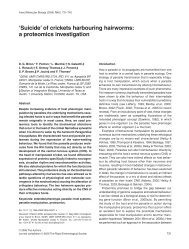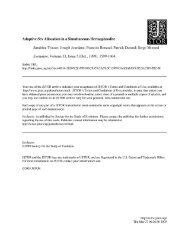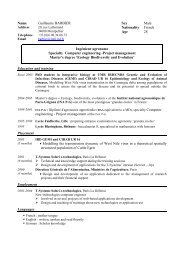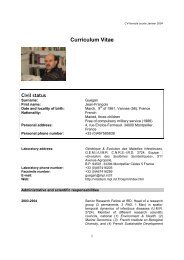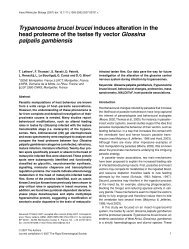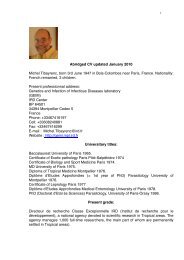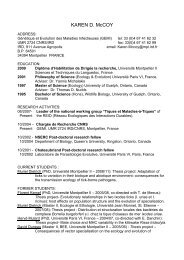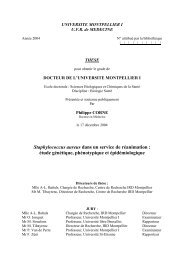écologie des virus influenza aviaires en Camargue - IRD
écologie des virus influenza aviaires en Camargue - IRD
écologie des virus influenza aviaires en Camargue - IRD
Create successful ePaper yourself
Turn your PDF publications into a flip-book with our unique Google optimized e-Paper software.
Annexe 2Appar<strong>en</strong>t competitionWith few exceptions, parasitic manipulation dramatically reduces host fitness. Notsurprisingly, manipulative parasites have be<strong>en</strong> shown to be involved in appar<strong>en</strong>t competitionprocesses (see Box 1), like other kinds of parasites. For instance, while the bird trematodeMicrophallus papillorobustus equally infects the two gammarids Gammarus ins<strong>en</strong>sibilis andGammarus aequicauda as (second) intermediate hosts, it does not alter their behaviour withthe same ease [16]. Infected G. ins<strong>en</strong>sibilis are always manipulated, displaying a suicidalbehaviour which increases their probability of predation by aquatic birds. By contrast, in G.aequicauda , host manipulation is observed only wh<strong>en</strong> infection occurs in juv<strong>en</strong>ilegammarids; in adults, M. papillorobustus has no significant effect on the crustacean’sbehaviour. In the field, populations of the two host species exhibit strongly contrastedpatterns of parasiteinduced mortality, indicating that M. papillorobustus acts as animportant mechanism regulating the d<strong>en</strong>sity of G. ins<strong>en</strong>sibilis populations only. Interestingly,the latter gammarid species is also known to possess a greater reproductive success than G.aequicauda. The manipulative parasite M. papillorobustus can thus favour the coexist<strong>en</strong>ce ofthe two gammarids wh<strong>en</strong> in sympatry [16].Along the same lines, a study analyzed the effects of bird acanthocephalans(Profilicollis antarcticus and Profilicollis novaezeland<strong>en</strong>sis) on two intertidal shore crabs,Macrophthalmus hirtipes and Hemigrapsus cr<strong>en</strong>ulatus, both species serving as intermediatehosts [17]. The two crab species are common inhabitants of sheltered mudflats in NewZealand and are frequ<strong>en</strong>tly found coexisting. It is typical for these two crab species to avoidpredation by burrowing into the sedim<strong>en</strong>ts at low tide; however, many individuals of bothspecies are also found totally exposed ev<strong>en</strong> wh<strong>en</strong> the tide is at its lowest. Exposed individualsof M. hirtipes (i.e. those still active at low tide), but not H. cr<strong>en</strong>ulatus, have significantlyhigher infection levels than did hidd<strong>en</strong> conspecifics. This result suggests that Profilicolliscystacanths, by altering hiding behaviour, can increase the vulnerability of their intermediatehost M. hirtipes to predation [17]. In this case, the prefer<strong>en</strong>tial manipulation of oneintermediate host species over another can directly influ<strong>en</strong>ce the population dynamics of M.hirtipes and also the relative abundances of other crab species occurring in the same habitat.The role of manipulative parasites in appar<strong>en</strong>t competition ph<strong>en</strong>om<strong>en</strong>a has also be<strong>en</strong>196


